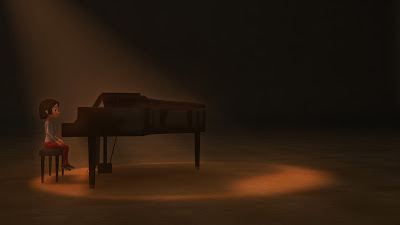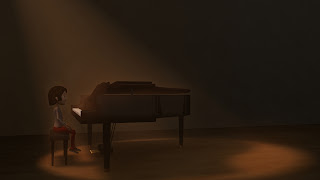In this short movie, the daughter’s faithfulness for her father is most striking. Even though years have passed, she did not let go. The tree next to the hill that leads to the sea is the element that draws the girl to remembering her father and hoping to find him there. The focus in this short movie is on loss and attachment and not nostalgia or memory that take the actors to previous moments they have lived.
Monday, 30 July 2012
Sunday, 29 July 2012
Documentation Strategy Seminar
Documentation will allow me to develop my ideas while tracking my thinking strategies and creative process. It will also allow me to come to a greater understanding of the way I go about things and the methodologies I use. The documentation process originally requires keeping an up to date working blog. This would involve posting weekly updates on how the work is progressing, with small texts on update progresses or sometimes playblasts or test renders of the work in progress.
The following phases have all been part of my documentation: Concept statement, character design and development, research, shot lists, storyboards, critique and feedback notes from tutors, evaluation of my learning and creative process.
I consider documentation as necessary aspect of my major study, because it allows us to keep and blog everything. This blog will keep acting as a documentation to my work and research in process.
Posts will be related to:
- The evaluation of my work and creative/production process.
- The evaluation of my learning processes.
My posts include/will include:
- My production WIP
- Inspirational artefacts and works and how they relate to my forefront
- Project management updates
- Commentary on topics that are related to the forefront of my field.
- A reflective evaluation of the methodology I adopted
- Continuous evaluation of what I learn
The following phases have all been part of my documentation: Concept statement, character design and development, research, shot lists, storyboards, critique and feedback notes from tutors, evaluation of my learning and creative process.
I consider documentation as necessary aspect of my major study, because it allows us to keep and blog everything. This blog will keep acting as a documentation to my work and research in process.
Posts will be related to:
- The evaluation of my work and creative/production process.
- The evaluation of my learning processes.
My posts include/will include:
- My production WIP
- Inspirational artefacts and works and how they relate to my forefront
- Project management updates
- Commentary on topics that are related to the forefront of my field.
- A reflective evaluation of the methodology I adopted
- Continuous evaluation of what I learn
Inspiration 1: La maison en petits cubes
Unlike other short films, "La Maison en petits cubes" doesn't show directly a character coping with loss, but a character with forgotten memories who later started to relive his memories while exploring the sunken house of his youth to look for his pipe.
This short movie also proves the phenomenological approach to this project showing how personal experience and memories can affect our perception of the world around us. It is interesting that even though this film resembles some of the other short movies that I will post about, in its lack of dialogue or spoken words, but the focus on the music in this case stimulates the senses of the audience and helps them to relate easier to the unnamed character who in the beginning was just a an object in the movie but later on became a more sympathetic character that attracts the attention of the viewers.
This project also shows the "father" who was just an object of curiosity in the opening scene but later became an element dominated by emotions, with the help of the of musical transitions and lack of dialogue, reliving memories of his daughter playing piano after he noticed the red piano on the floor.
Wednesday, 25 July 2012
Room Scene - Test 3 - probably the last one
Taking into consideration Martin's feedback in the following photo
I adjusted the lighting accordingly:
I adjusted the lighting accordingly:
-Changed the gobos photo attached to the spotlight (moonlight) and added a blue layer adjustment to it.
Thursday, 19 July 2012
Wednesday, 18 July 2012
Making of the room: 3
Modeling, shading, texturing
To be able to texture the teddy, I first UV mapped it and created seamless fabric textures with their bumps in Photoshop.
To be able to texture the teddy, I first UV mapped it and created seamless fabric textures with their bumps in Photoshop.
Tuesday, 17 July 2012
Lighting/mood references 2
Credits go to Oasim Karmieh (www.pixelophy.com)
It's relatively similar to my project since it relates to childhood memories ..
(his WIP at http://www.pixelophy.com/?p=1043)
Monday, 16 July 2012
Sunday, 15 July 2012
Saturday, 14 July 2012
Piano Scene - Lighting and Shading - Test 3
To get rid of the horizon line that was present in my last render, I created a curved nurbs plane and applied a U Ramp shader to it (with linear interpolation). added the wood texture to the lower ramp and a gray one to the upper ramp.
Below is an image of the graph network of my shader:
(the brightness n contrast are slightly adjusted in photoshop, same effect is doable in postproduction via AE)
Friday, 13 July 2012
Subsurface scattering material for the skin
Subsurface scattering is a Mental Ray material option to render materials like skin.
Old test render:
to track the difference and improvement:
Applying the new shader:
This is a test render that shows the changes in the material of the girl's skin,
The technique I used is subsurface scattering skin shader, connected it to my UV mapped texture.
Before (without SSS on the hands shader):
After (with SSS on the hands shader)
Materials light rays are not always reflected at the surface, but can also scatter under the surface and leave at another position which leads to a softer appearance, as light is blurred out over the surface.
Old test render:
to track the difference and improvement:
Applying the new shader:
This is a test render that shows the changes in the material of the girl's skin,
The technique I used is subsurface scattering skin shader, connected it to my UV mapped texture.
Before (without SSS on the hands shader):
After (with SSS on the hands shader)
The picture below is a capture of the shader's graph network linked to the head texture:
Thursday, 12 July 2012
Lighting/mood references
(don't know who is the owner of this photo)
Tuesday, 10 July 2012
Monday, 9 July 2012
Little Girl - Eleven Rig (Editing the UV maps)
I had to recreate my own UV maps to apply different textures to the rig.
UV map of the body
UV map of the head
Color map of the head.
The strawberry fabric texture was downloaded through:
www.mayang.com/textures
Saturday, 7 July 2012
Friday, 6 July 2012
Thursday, 5 July 2012
UV maps for the head - daddy
using Autodesk Maya and Adobe photoshop CS5
UV Layout of the daddy's head
Skin specular map
Skin bump map
Skin color map
Tuesday, 3 July 2012
Piano Scene - Lighting and Shading - Test 2
Adjustments:
- Added Ambient occlusion pass between the white keys was not enough to prevent them from blending together, I slightly scaled them down in width to solve that issue.
- Added mia_material_X shaders to the brass material in the piano (pedals, etc..)
-Added a cube fog, tweaking the fog density, glow intensity, light scatter, etc.
-Adjusted the spotlight attributes, color, cone shape, penumbra, added fog effect to it...
-Textured the floor
Things to fix:
The sharp horizon line behind the piano, making the scene very linear and non-dreamy..
Sunday, 1 July 2012
Piano Scene - Lighting and Shading - Test 1
This is a test render of the scene with the piano. of course its not the final version, it isn't isn't lit for the actual animation yet . I'm planning to add an HDRI image instead of the default checker to the sphere. worked on the shaders and the lights. I am not satisfied by how the shadows look, I think they are too sharp.
The environment in this scene will be very simple. since I will be adding depth of field and maybe a bit of vignette to the camera. I am still researching how I can make it look more dreamy/foggy, to emphasize on the feeling of memory...
Notes and Feedback from Martin:
- Turn up the anti-aliasing quality for the final render
- Ambient occlusion pass between the white keys to prevent them from blending together.
- Add a few specular only lights to add highlights to it to explain edges and reveal the form :The front of the piano doesn't show any detail, it's all black, get some light onto it.
- Add a polygon plane off camera (set this to be not visible to primary rays / camera) but visible to reflections / secondary rays, and possibly make it black colour but add colour to the incandescence setting, and this will make the plane appear in the piano as a reflection.
-The brass shader on the piano looks a bit plastic and not very brass like
Subscribe to:
Posts (Atom)


































